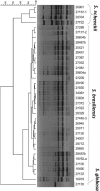Rapid identification of Sporothrix species by T3B fingerprinting
- PMID: 22403427
- PMCID: PMC3372112
- DOI: 10.1128/JCM.00450-12
Rapid identification of Sporothrix species by T3B fingerprinting
Abstract
This article describes PCR fingerprinting using the universal primer T3B to distinguish among species of the Sporothrix complex, S. brasiliensis, S. globosa, S. mexicana, and S. schenckii. This methodology generated distinct banding patterns, allowing the correct identification of all 35 clinical isolates at the species level, confirmed by partial calmodulin (CAL) gene sequence analyses. This methodology is simple, reliable, rapid, and cheap, making it an ideal routine identification system for clinical mycology laboratories.
Figures



References
-
- Cooper CR, Dixon DM, Salkin IF. 1992. Laboratory-acquired sporotrichosis. J. Med. Vet. Mycol. 30:169–171 - PubMed
-
- Felsenstein J. 1985. Confidence limits on phylogenies: an approach using the bootstrap. Evolution 39:783–791 - PubMed
-
- Freitas DF, Valle ACF, Almeida-Paes R, Bastos FI, Gutierrez-Galhardo MC. 2010. Zoonotic sporotrichosis in Rio de Janeiro, Brazil: a protracted epidemic yet to be curbed. Clin. Infect. Dis. 50:453. - PubMed
Publication types
MeSH terms
Substances
Associated data
- Actions
- Actions
- Actions
- Actions
- Actions
- Actions
- Actions
- Actions
- Actions
- Actions
- Actions
- Actions
- Actions
- Actions
- Actions
- Actions
- Actions
- Actions
- Actions
- Actions
- Actions
- Actions
- Actions
- Actions
- Actions
- Actions
- Actions
- Actions
- Actions
- Actions
- Actions
- Actions
- Actions
- Actions
- Actions
- Actions
- Actions
- Actions
- Actions
- Actions
- Actions
- Actions
- Actions
LinkOut - more resources
Full Text Sources

